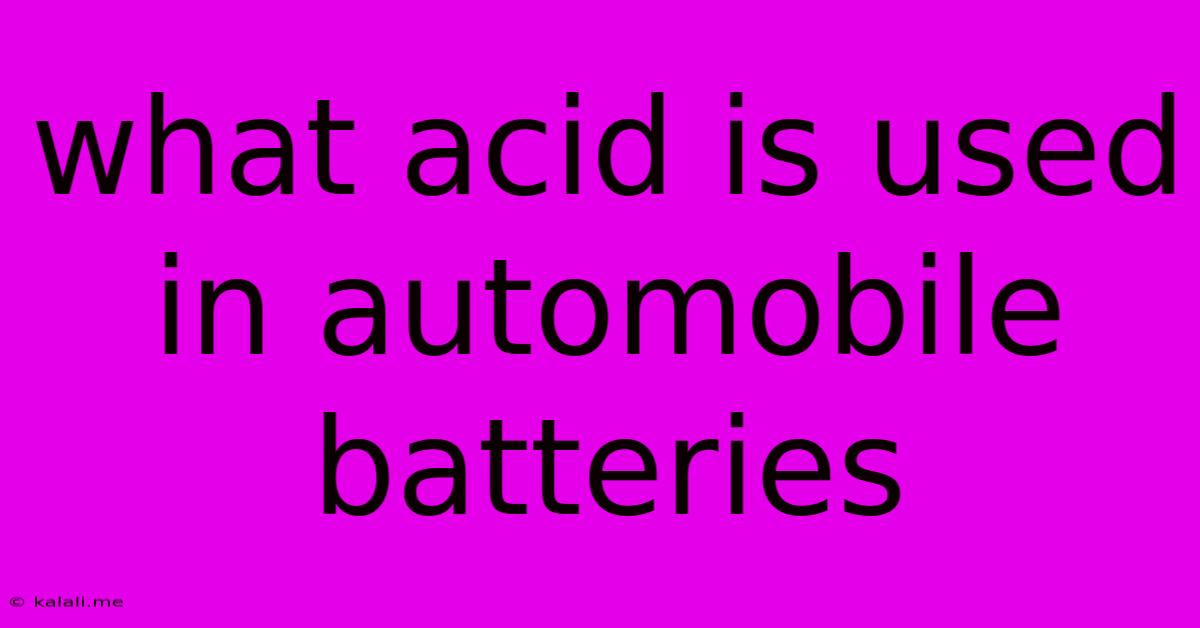What Acid Is Used In Automobile Batteries
Kalali
Jun 11, 2025 · 3 min read

Table of Contents
What Acid is Used in Automobile Batteries? Understanding Sulfuric Acid and Car Batteries
Car batteries are a vital component of any vehicle, providing the power needed to start the engine and run various electrical systems. But what makes these batteries work? The answer lies in a powerful and corrosive chemical: sulfuric acid. This article will delve into the specifics of sulfuric acid's role in automobile batteries, exploring its properties and why it's the ideal choice for this application.
Understanding Sulfuric Acid (H₂SO₄)
Sulfuric acid is a strong mineral acid, meaning it readily donates protons (H⁺ ions) in a solution. This property is crucial to its function in a car battery. It's a highly corrosive liquid, typically appearing as a colorless, odorless, and viscous liquid in its pure form. However, the sulfuric acid in car batteries is a diluted solution, typically around 30-38% concentration by weight. Even in this diluted form, it remains highly corrosive and requires careful handling.
How Sulfuric Acid Powers Your Car Battery
A car battery is a lead-acid battery, a type of electrochemical cell. It consists of:
- Lead plates (electrodes): These plates are made of lead and lead dioxide, acting as the anode (-) and cathode (+) respectively.
- Sulfuric acid electrolyte: This solution acts as the medium for the chemical reactions.
- Separator: This porous material prevents direct contact between the lead plates, preventing short circuits.
The chemical reaction within the battery involves the sulfuric acid. When the battery discharges (provides power), the sulfuric acid reacts with the lead plates, producing lead sulfate and water. This reaction releases electrons, creating an electric current. The process is reversed during charging, regenerating the lead plates and replenishing the sulfuric acid concentration.
Why Sulfuric Acid is the Ideal Choice
Several properties make sulfuric acid suitable for car batteries:
- High conductivity: Its ability to conduct electricity efficiently ensures effective current flow within the battery.
- Readily reversible reaction: The chemical reaction involving sulfuric acid is readily reversible, allowing for efficient charging and discharging cycles.
- Cost-effectiveness: Sulfuric acid is relatively inexpensive and readily available, making it a cost-effective choice for mass production.
- High energy density: Lead-acid batteries with sulfuric acid electrolyte offer a good balance between energy density and cost.
Safety Precautions with Sulfuric Acid
It’s crucial to remember that sulfuric acid is corrosive. Always handle car batteries with care and wear appropriate safety gear, including gloves and eye protection. Avoid direct contact with the acid and ensure proper ventilation when working with car batteries to minimize exposure to any fumes. Spills should be handled immediately with appropriate neutralizing agents and cleaned thoroughly.
Conclusion
In summary, sulfuric acid plays a critical role in the functionality of automobile batteries. Its unique properties—high conductivity, reversible chemical reactions, cost-effectiveness, and high energy density—make it the ideal choice for this application. However, its corrosive nature necessitates careful handling and safety precautions whenever working with car batteries. Understanding the role of sulfuric acid enhances appreciation for the fundamental chemistry behind this essential automotive component.
Latest Posts
Latest Posts
-
How Many Ears Of Corn To A Bushel
Jul 01, 2025
-
How Many Months Are In A Quarter
Jul 01, 2025
-
How Much Does A 12 Pack Of Pop Weigh
Jul 01, 2025
-
How Many Shots In A Half Gallon
Jul 01, 2025
-
Someone Once Told Me The World Was Macaroni
Jul 01, 2025
Related Post
Thank you for visiting our website which covers about What Acid Is Used In Automobile Batteries . We hope the information provided has been useful to you. Feel free to contact us if you have any questions or need further assistance. See you next time and don't miss to bookmark.